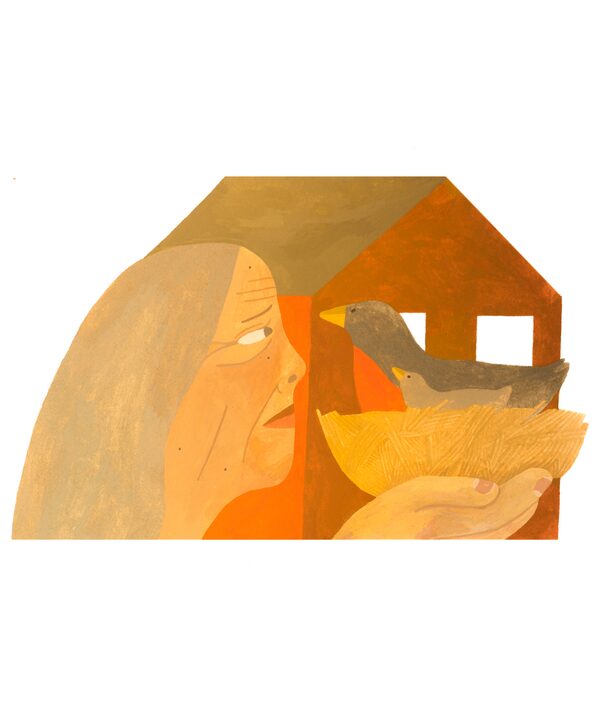First Person is a daily personal piece submitted by readers. Have a story to tell? See our guidelines at tgam.ca/essayguide.

Illustration by Mary Kirkpatrick
The first time a robin made her nest in the corner above our front door I was thrilled. It might have been the heat from the lamp tucked up there for security, the motion light, that she liked, or the way the plastic curved – an enticing pre-nest mould. As she built her nest, I discovered I could watch from another security camera. She came and went, with bits of string and grass and who knows what else, all in black and white. I warned my husband to open the door slowly as not to startle her, which became our daily empathy practice once she had laid her eggs.
Who knew that we could be so generous, so kind as to worry about the mother bird hatching her eggs? When leaving the house, even in the midst of can’t-find-our-phones and got-the-wrong-keys and snatching up our coats, we never forgot to pause and turn the doorknob like a thief in the night. We’d turn around and just as gently push the door shut, the same way we had shut the nursery door decades ago after an exhausting ritual of rocking and walking and stroking a tiny babe through the bars of the crib.
I have always loved birds. When I was a child, we had a budgie, a beautiful blue feathered bird that lived in a tall cage in the corner of our dining room. The budgerigars, a wild bird, has been domesticated since the 1850s and are the second most popular pet after cats and dogs. They are a small parakeet and can mimic human speech. Our Harley sang but didn’t talk. Each night my mother covered Harley’s cage with a towel. I often let him sit on my finger. It was my job to clean the cage, and for some unfathomable reason, I did this each Saturday on the driveway, in the carport, not inside the house. Did you guess that Harley flew away? I can’t remember if I was saddened or ecstatic at his release. I know we didn’t get another bird.
Now, imagine an old woman who loves birds so much her whole Christmas tree is clip-on birds, a woman who has not one but two bird clocks, one set a few minutes early so that first she hears an owl and then right away the mourning dove. Who, when she heard the name of her first grandchild was going to be Wren, burst into tears at the perfection of it.
I have objectified and beheld birds as a sign of God’s imagination and cleverness and creativity. For years, I’ve catalogued birds viewed in the forest from the deck; sat for hours with binoculars marvelling at a tiny wren squeezing into a mostly decorative birdhouse to quiet the noisy chirps from inside; planted petunias for the hummingbirds, listened to a scratchy album of bird calls found at a garage sale and cursed my phone for being inside when I saw my first Pileated woodpecker (his huge red cap and laugh really did sound like Woody Woodpecker).
But when the robin’s nest went up, it never occurred to me to worry about what was underneath it. And underneath was not a soft spongey water-soaked spring lawn but the hard asphalt of our driveway.
I knew the word fledging, what writer does not? But I did not know that a fledgling bird is a bird that is learning to fly. I had used the metaphor of mother birds pushing the babies from the nest – used it on myself, even though my adult children flew the coop on their own. I gladly moved my office into a free bedroom and painted the walls to re-feather my empty nest.
What I didn’t know is that robin babies often cannot fly on the first trip out. Fledglings are meant to land, somewhere beneath the nest and waddle around to get their strength. They hide in the long grass. The parents feed them and divebomb predators and wait until they are strong enough to fly.
I thought of my daughter, who, when she left home at 19, rented an apartment that was walking distance from our home. How when her sink was overflowing, she called her dad not the superintendent. The stacks of Tupperware containers she lugged home hot and lugged back, empty and clean. Not that different from a fledgling bird.
One afternoon I came home to find smashed chicks on the asphalt. I bent, horrified, to pick them up. Had someone grabbed them from the nest? Some predator, perhaps the blue jay I’d also admired? The mother bird was still there, still with one tiny yellow beak poking out. I quickly Googled the disaster and that’s when I realized: My driveway was not a good place to launch these babies.
I was afraid to move the nest, afraid the mother would smell humans on it and abandon the last remaining baby. Another myth, said Google. So we got a ladder, the mom flew off and we moved the nest to the crook of a tree nearby, one with grass and foliage near its base. When the nest was empty, I told myself that the little one had made it.
The next time that cupped lamp attracted a bird, I cleared out her work until she was too frustrated to stay. Hard asphalt was never part of God’s design for birds.
MJ Malleck lives in Kitchener, Ont.
Sign up for the weekly Parenting & Relationships newsletter for news and advice to help you be a better parent, partner, friend, family member or colleague.